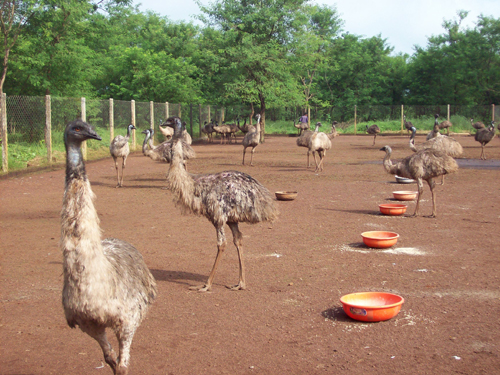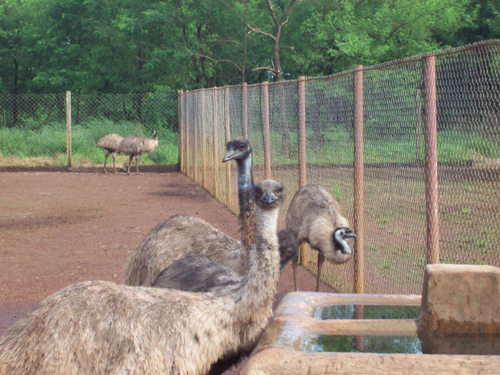Feeding Management
Feeding
A special diet similar to poultry feed specifications, supplemented with farm grown lucerne and other pasture, is fed at each of the different stages of growth.
Feeding and watering requirement:
For Feed and water, one Container each per 10 birds is recommended. We may use 10 liter Galvanized buckets for water.Birds require clean and bacteria free water. Water source should be tested for good portability. In well water additives likes Potassium permanganate may be used. Also Alum may be used for removing any turbidity. An adult Bird requires 6 to 7 liters of water per day. Water pots should be always kept clean and kept full all times. Even in nights, birds may need water. Feed should be given only in the prescribed timings only. Morning - 7.00 a.m. to 1l.30 a.m. Evening - 3.00 p.m. to 6.30 p.m. 1.00 p.m to 2.00 p.m we may provide with greens, finely chopped green vegetables.
Age of the birds in months
|
Quantity per bird per day( in grams) |
3 |
250 |
4 |
300 |
5 |
350 |
6 |
400 |
7 |
500 |
8 |
600 |
9 |
700 |
10 |
800 |
11 |
800 |
12 |
900 |
13 |
900 |
14 |
900 |
15 |
900 |
16 |
900 |
17 |
900 |
18 |
900 |
Supplements along with feed:
Calcium: The calcium in the form of Syrup should be added to the drinking water. The following brand names are recommended which are easily available in the market.
Dosages: The following table shows the dosages as per age.
Age |
Quantity in ml per day per Bird |
3 to 5 months |
1.0 |
5 to 8 months |
2.0 |
8months &above |
3.0 |
Vitamin A, D3: Available in the form of Syrup. This is also should be added to drinking water the recommended brand names are given below.
Dosages: The following table shows the dosages as per age.
Age |
Quantity in ml per day per Bird |
3 – 9 months |
0.5 |
9months & above |
1.0 |
Vitamin B Complex: Available in the form of Syrup also should be given through drinking water. Recommended Brand names are as under: Groviplex , B Plex.
Dosages: The following table shows the dosages as per age.
Age |
Quantity in ml per day per Bird |
3-5 months |
1.0 |
5-8 months |
2.0 |
8months & above |
3.0 |
Feeding schedule for emu:
|
Starter |
Grower |
Finisher |
Metabolizable energy / Kcal/Kg. |
2685 |
2640 |
2860 |
Crude Protein % |
22 |
20 |
17 |
Methionine % |
0.48 |
0.44 |
0.38 |
Lysine % |
1.10 |
0.94 |
0.78 |
Crude fibre |
6 to 8 |
6-8 |
6-7 |
Calcium |
1.5 |
1.3 |
1.2 |
Emu - nutritional requirement for growing birds
Anatomical studies have revealed that the digestive system of emus comprises an oesophagus, proventriculus, gizzard, a small intestine (duodenum, jejunum and ileum), caeca, rectum and cloaca. In this respect they are similar to poultry with the exception that they have no distinct crop. The proventriculus, however, is quite distensible and possibly could serve as an organ for food storage. The total length of the digestive tract of the emu relative to its liveweight is approximately ten times less than for the domestic fowl.
The time taken for food to pass through the digestive tract is variable, depending in part on the nature of the item ingested. Plant particulate matter will take an average of five to six hours, intact wheat grains from less than a day up to two days. Glass marbles have been observed to be retained for 100 days. It would be expected that large particles of insoluble grit would be retained for a period in the gizzard and be effective in aiding the physical maceration of food.
Nutritional requirements
In considering nutrition we are primarily concerned with supplying the emu with all the nutrients essential to its maintenance, growth and reproduction. Although the nutritional requirements of emus are poorly understood it is known that, in common with other birds, emus must obtain some basic nutrients from their feed.
Energy
Ingredients high in carbohydrates and/or fats are energy sources and include the cereal grains and full-fat soybean meal, for example.
Protein
Feed protein is broken down in the intestines into its constituent amino acids which may then be absorbed into the blood and used for muscle growth. Thus the emus requirement for protein is in effect a requirement for amino acids and so, it is the amino acid composition of the feed that is the crucial factor. There are more than 20 amino acids of which about 11 cannot be manufactured by the emu and must therefore be present in the feed. Of this methionine, lysine, theonine, isoleucine and tryptophan are likely to be in shortest supply in emu diets.
Vitamins
These are substances distinct from protein, carbohydrate or fat but which are essential in small amounts for normal growth, development and health. They must be present in the diet although some vitamins may be obtained by coprophagy or be synthesised by micro-organisms in the intestinal tract.
Minerals
These are essential for normal growth, development and health. They must be present in the diet either in relatively small amounts, for example calcium, phosphorus, manganese, sodium and chloride or only trace amounts, for example potassium, iron, copper, iodine, zinc, selenium.
Fibre
Emus can digest only about 20 percent of the cellulose and lignin in their diet. It has been estimated that the energy derived from this can satisfy about 11 percent of their energy requirement for maintenance. Their limited capacity to digest fibre is consistent with the observation that, in the wild, emus eat large insects, small vertebrates and those parts of plants in which nutrients are concentrated such as growing shoots, flowers, fruits and seeds. It also suggests that immature, rapidly growing emus should be fed diets relatively low in fibre and similar in nature to conventional poultry grower diets. Some fibre is necessary to promote healthy gut function but in nutritional terms its value is low.
 
Feeding & Watering
Supplying nutritional requirements
The ability to supply the nutritional requirements of emus depends on the feed composition, that is, the concentrations of the essential nutrients in the feed and the amount of feed consumed by the birds. When all of the emus' diet comprises a compounded feed, quite precise control can be had over their intake of nutrients. When a proportion of their diet is derived from range their quantitative intake of available nutrients is less predictable. For rapidly growing emus destined for slaughter it seems logical to reduce the dependence on range and instead supply compounded diets formulated to least cost specifications.
An examination of the growth curve of emus suggests that a three-phase system of feeding may be appropriate. Phase one could be known as a starter phase and would cover the period from hatching to when the emus attained an average live weight of approximately 10 kg (14 weeks of age). Phase two, a grower phase, would cover the period from 10 kg live weight to 25 kg live weight (34 weeks of age). Phase three, a finisher phase, would be that period from 25 kg live weight through to slaughter. The purpose of dividing the growing period into phases is simply to signify periods in which the emu requires a change in its dietary nutrient composition to best meet its current level of production. However, until the appropriate nutrient response data are known, the suggestion of a three phase system is only tentative.
Table 1. Requirements for lysine, methionine plus cystine and energy for emus at different growth stages
Requirements |
Starter |
Grower |
Finisher |
Metabolisable energy (ME, MJ/kg) |
11.2 |
10.2 |
10.2 |
Lysine (%) |
0.9 |
0.8 |
0.7 |
Methionine + cystine (%) |
0.7 |
0.7 |
0.6 |
Calcium (%) |
1.6 |
1.6 |
1.6 |
Available phosphorus (%) |
0.6 |
0.6 |
0.6 |
Sodium (%) |
0.2 |
0.2 |
0.2 |
Because the growth rate and feed intake of emus will vary with changes in the energy concentration of the diet it is more appropriate to relate the requirement for lysine and other amino acids to energy content. In practice this is done by expressing the requirement for lysine as glysine per mega joule of ME. Other amino acids are expressed as a proportion of the lysine level. These conventions have been adopted in the table of suggested nutrient requirements of growing emus. These diets should contain a comprehensive chicken grower vitamin and mineral premix.
Table 2. Nutrient requirements of growing emus
Nutrient requirements |
Starter |
Grower |
Finisher |
Metabolisable energy (MJ/kg) |
11.2 |
11.0 |
11.0 |
Lysine (g/MJ) |
0.80 |
0.75 |
0.70 |
Methionine (ratio to lysine) |
0.50 |
0.50 |
0.50 |
Methionine + cystine (ratio to lysine) |
0.80 |
0.80 |
0.80 |
Tryptophan (ratio to lysine) |
0.19 |
0.19 |
0.19 |
Isoleucine (ratio to lysine) |
0.65 |
0.65 |
0.65 |
Threonine (ratio to lysine) |
0.60 |
0.60 |
0.60 |
Calcium (%) |
1.6 |
1.60 |
1.6 |
Available phosphorus (%) |
0.6 |
0.6 |
0.6 |
Sodium (%) |
0.2 |
0.2 |
0.2 |
The energy concentration adopted for diets for growing emus is usually that which minimises the cost of feeding per unit of end product produced. With emus having such a diversity of end products and, in the absence of specific feeding regimens tailored to specific end products, it is advised that the energy level which minimises the cost per tonne of the diet be selected having regard to meeting the amino acid specifications given earlier. Too low an energy level, however, will result in a bulky diet which may restrict feed intake particularly in young birds to levels which fail to meet the energy needs of the bird for optimum growth. In the starter phase a minimum metabolisable energy level of 11.2 MJ/kg is recommended.
Leg disorders
The development of leg deformities has been cited as a common problem in captive bred emus, with clinical signs usually appearing within the first two months of life. A number of different, possibly interrelated conditions may be involved as well as calcium/phosphorus imbalance and methionine deficiency. Maternal nutrition may also be implicated. O'Malley (1991) has observed that restricting the time of access to mixed feed to a period of only four hours each day from about 10 to 30 days of age will minimise the incidence of leg disorders in emu chicks. Interestingly, feed restriction has similarly been found effective in reducing these disorders in meat chickens. However, the incidence of leg deformities has not decreased in the past 40 years despite an intensive research effort in this area.
Table 3. Example of diets for growing emus (percentage composition)
Composition (percentage) |
Starter |
Growe |
Finisher |
Sorghum |
34.7 |
30.9 |
31.6 |
Wheat |
36.0 |
30.0 |
30.0 |
Meat and Bone Meal (55%) |
10.3 |
10.0 |
10.1 |
Soyabean Meal (45%) |
3.2 |
- |
- |
Sunflower Meal (32%) |
9.9 |
8.6 |
6.7 |
Cottonseed Meal |
2.9 |
- |
- |
Millrun |
- |
15.0 |
15.0 |
Lucerne Meal |
- |
2.9 |
4.1 |
Limestone |
1.8 |
1.5 |
1.5 |
Salt |
0.28 |
0.21 |
0.20 |
DL Methionine |
0.23 |
0.19 |
0.17 |
L Lysine HCl |
0.23 |
0.17 |
0.11 |
Mineral and Vitamin Premix |
0.50 |
0.50 |
0.50 |
(source: http://www.dpi.qld.gov.au/cps/rde/dpi/hs.xsl/27_2721_ENA_HTML.htm )
| 

